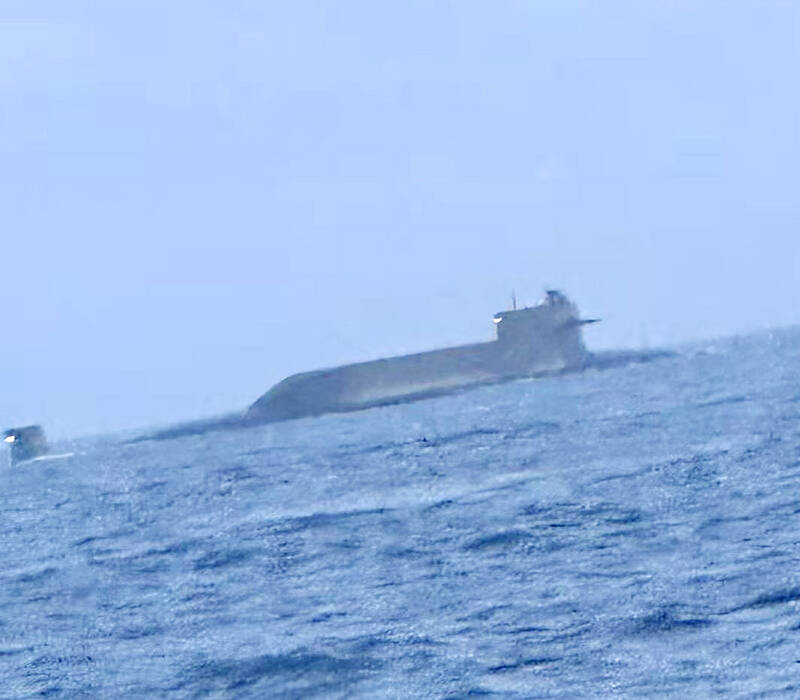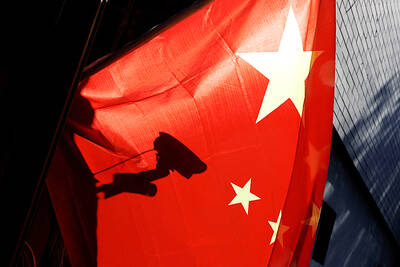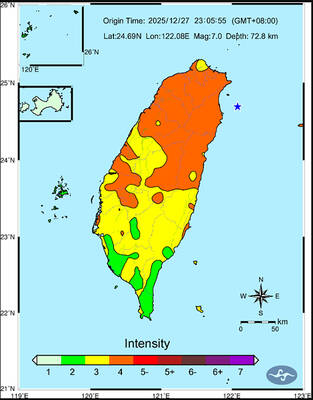After pictures appeared online of a Chinese nuclear submarine surfacing in the Taiwan Strait near some Taiwanese fishers, Minister of National Defense Wellington Koo (顧立雄) yesterday said the military has a “grasp” of the situation.
Taiwanese media published pictures taken by a Taiwanese fishing boat in the Taiwan Strait as dawn broke yesterday. It appeared to be a nuclear-armed Jin-class ballistic missile submarine.
The vessel surfaced near the Kinmen islands.

Photo courtesy of a fisher
Asked about the submarine, Koo said the military has a “grasp” of the intelligence situation, but declined to say how it was being monitored or give any further details.
The Chinese Ministry of National Defense did not immediately respond to a request for comment.
Nuclear-powered submarines can operate underwater for months at a time and ballistic-missile boats’ secretive missions mean they rarely surface.
A security source familiar with the situation said that the submarine was most likely returning to its home port in Qingdao from the South China Sea.
The source said that the submarine might have surfaced because it experienced a malfunction.
Taiwanese military experts were divided in opinion on the matter, but concurred that the abnormal event should be watched closely.
Lu Li-shih (呂禮詩), a former lieutenant commander in the navy, said that from available information, the Type 094 Jin-class nuclear-powered ballistic missile submarine was on a northerly course and was possibly returning to the Bohai Shipyard for routine maintenance.
According to publicly available information, the submarine was within Chinese territorial waters at the time of the sighting, Lu said.
The sub could have returned via the Taiwan Strait to avoid joint US-Japanese military exercises east of Taiwan, as the US would have detected it and recorded its acoustics, he said.
The submarine would have had to travel at periscope depth in the Taiwan Strait, making detection and recording of its acoustics possible anyway, Lu said, adding that surfacing and being escorted back to port was the ideal resolution.
Military expert Lu Te-yun (盧德允) said nuclear-powered ballistic submarines usually deliver the “first strike” in the event of war.
A Type 094 passing through the Taiwan Strait is “highly abnormal,” he said, adding that the sudden surfacing and the appearance of an escort ship could hint at the boat experiencing a mechanical malfunction.
“We must be fully alert to China’s continued military harassment and ‘gray zone’ threats and must always understand China’s constant salami-slicing attempts to unilaterally change the status quo,” Koo said.
“We must be alert at all times, but not panic nor be apathetic, and calmly deal with the situation in the Strait,” he said. “We won’t be the one provoking and we call on China not to be a troublemaker.”
Taiwan detected 20 Chinese military planes and seven vessels around the nation in the previous 24 hours, the Ministry of National Defense said in its daily report on Chinese military activities yesterday morning.
In other news, the Taiwanese military enthusiast group “Taiwan ADIZ” said that people living in Kinmen and Lienchiang counties on Monday had reported multiple Chinese civilian planes exhibiting “abnormal” behavior and deviating from civilian flight paths to fly over Kinmen and Matsu.
The air force said it registered 58 civilian planes deviating from their planned routes due to bad weather, with 15 flying over Kinmen and eight flying over Matsu.
The air force said it monitored the aircraft closely, adding that the planes had been directed to those flight paths and that aviation traffic regulators had told them to maintain an altitude of 6,100m to 12,200m.
The Civil Aviation Administration said that it had received notice from its Chinese peer that due to bad weather, Chinese planes would deviate from their flight paths and pass over the islands. It said it asked the Chinese planes not to enter Taiwan’s airspace, a request that the planes heeded.
Additional reporting by Yang Hsiao-ju, Tsai Tsung-hsien, and Tsai Yun-jung

A magnitude 7.0 earthquake struck off Yilan at 11:05pm yesterday, the Central Weather Administration (CWA) said. The epicenter was located at sea, about 32.3km east of Yilan County Hall, at a depth of 72.8km, CWA data showed There were no immediate reports of damage. The intensity of the quake, which gauges the actual effect of a seismic event, measured 4 in Yilan County area on Taiwan’s seven-tier intensity scale, the data showed. It measured 4 in other parts of eastern, northern and central Taiwan as well as Tainan, and 3 in Kaohsiung and Pingtung County, and 2 in Lienchiang and Penghu counties and 1

FOREIGN INTERFERENCE: Beijing would likely intensify public opinion warfare in next year’s local elections to prevent Lai from getting re-elected, the ‘Yomiuri Shimbun’ said Internal documents from a Chinese artificial intelligence (AI) company indicated that China has been using the technology to intervene in foreign elections, including propaganda targeting Taiwan’s local elections next year and presidential elections in 2028, a Japanese newspaper reported yesterday. The Institute of National Security of Vanderbilt University obtained nearly 400 pages of documents from GoLaxy, a company with ties to the Chinese government, and found evidence that it had apparently deployed sophisticated, AI-driven propaganda campaigns in Hong Kong and Taiwan to shape public opinion, the Yomiuri Shimbun reported. GoLaxy provides insights, situation analysis and public opinion-shaping technology by conducting network surveillance

Taiwan is gearing up to celebrate the New Year at events across the country, headlined by the annual countdown and Taipei 101 fireworks display at midnight. Many of the events are to be livesteamed online. See below for lineups and links: Taipei Taipei’s New Year’s Party 2026 is to begin at 7pm and run until 1am, with the theme “Sailing to the Future.” South Korean girl group KARA is headlining the concert at Taipei City Hall Plaza, with additional performances by Amber An (安心亞), Nick Chou (周湯豪), hip-hop trio Nine One One (玖壹壹), Bii (畢書盡), girl group Genblue (幻藍小熊) and more. The festivities are to

AFTERMATH: The Taipei City Government said it received 39 minor incident reports including gas leaks, water leaks and outages, and a damaged traffic signal A magnitude 7.0 earthquake struck off Taiwan’s northeastern coast late on Saturday, producing only two major aftershocks as of yesterday noon, the Central Weather Administration (CWA) said. The limited aftershocks contrast with last year’s major earthquake in Hualien County, as Saturday’s earthquake occurred at a greater depth in a subduction zone. Saturday’s earthquake struck at 11:05pm, with its hypocenter about 32.3km east of Yilan County Hall, at a depth of 72.8km. Shaking was felt in 17 administrative regions north of Tainan and in eastern Taiwan, reaching intensity level 4 on Taiwan’s seven-tier seismic scale, the CWA said. In Hualien, the